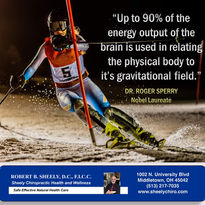Chiropractic Care: A Modern Approach
At Middletown Spine and Injury - Sheely Chiropractic, we begin by thoroughly evaluating the spine to identify any areas of dysfunction or misalignment. These misalignments, often referred to in chiropractic care as "subluxations," can interfere with normal nerve function. While the term "subluxation" has historical roots, we now understand these spinal shifts more clearly in terms of biomechanics and their impact on the nervous system.
We use state-of-the-art diagnostic tools, such as X-rays and advanced palpation techniques, to pinpoint where and how these spinal misalignments occur. By correcting these issues, we aim to restore optimal function to the nervous system.
The Science Behind Chiropractic
Chiropractic care is rooted in the well-established understanding that the nervous system plays a critical role in regulating all bodily functions. When nerve communication is disrupted—whether through mechanical compression or misalignment of vertebrae—this can impact the body’s ability to maintain balance and health.
Through precise spinal adjustments, we alleviate pressure on the nerves, allowing the body to restore itself and function optimally without the need for drugs or invasive procedures.

Specific Spinal Adjustments vs. General Spinal Manipulation
At Middletown Spine and Injury - Sheely Chiropractic, we emphasize the importance of specific skilled spinal adjustments as opposed to general spinal mobilization or manipulation. I provide a biomechanical evaluation through postural and motion assessments, testing, and frequently X-rays, ensuring a precise diagnosis of any dysfunction in the spine.
Spinal Manipulation refers to a thrust applied to any spinal segment, regardless of whether it is dysfunctional. While this can induce a mechanoreceptive response in the central nervous system (CNS), it is unlikely to have the same effect as a targeted adjustment. Spinal manipulation lacks the specificity required to address areas of central segmental motor control (CSMC) problems, where biomechanical dysfunction, degenerative soft tissue changes, or biopathophysiological issues may exist.
On the other hand, a Chiropractic Spinal Adjustment involves a High-Velocity, Low-Amplitude (HVLA) thrust directed at a specific CSMC problem. Adjustments to segments with a CSMC issue can significantly improve vertebral motor control by sending a focused stream of mechanoreceptive input to the CNS. This not only enhances spinal function but may also positively impact the entire body’s function by improving the body's overall coordination and response to nerve signals.
The Role of X-rays in Chiropractic Diagnostics
At Sheely Chiropractic, we use advanced digital X-ray analysis to assess the spine, particularly in trauma cases where ligament damage is a concern. One of the key conditions we evaluate is Alteration of Motion Segment Integrity (AOMSI), which refers to a loss of normal movement between spinal segments due to ligament injury. Identifying AOMSI is critical in determining the extent of trauma and the appropriate treatment plan for patients suffering from spinal injuries.
By employing the latest research and technology, such as Biokinemetrics ChiroSight Digital X-Ray Software, we can detect even subtle abnormalities in spinal motion and structure that may not be visible through traditional examination techniques. This approach ensures that our diagnosis is both precise and evidence-based, providing a clearer picture of biomechanical pathology and enabling us to address the underlying causes of pain and dysfunction effectively.
Understanding the Role of Spinal Misalignments
When a vertebra becomes misaligned, it can put pressure on the surrounding nerves, leading to discomfort or pain. In some cases, this can result in referred pain or radiating symptoms to other parts of the body, depending on where the nerve travels. Our goal is to correct these dysfunctions using hands-on spinal adjustments and cutting-edge technologies that enhance the healing process.
A Holistic Approach to Health
Chiropractic care is not only about symptom relief; it is a comprehensive approach to health. Regular spinal evaluations and adjustments help prevent future issues and promote long-term well-being. Chiropractors are trained to understand the complexities of vertebral misalignments and even extremity joint dysfunctions and how they impact the body’s intricate communication system.
How Nerve Interference Affects the Body
When vertebrae are misaligned, the resulting nerve interference can disrupt the signals between the brain and the rest of the body. This interference can impact organ function, muscle coordination, and tissue health. By addressing these issues early, chiropractic care helps restore the body’s natural capacity for healing and balance.
A Focus on Evidence-Based Care
While the term "subluxation, has been used since the time of Hippocrates, modern chiropractic care focuses on the evidence behind spinal adjustments and their effects on the nervous system. D.D. Palmer, the founder of chiropractic, originally theorized that even slight misalignments could cause nerve pressure. Today, we continue to build on that understanding, utilizing research and clinical data to deliver safe, effective care and use terms like Vertebral Subluxation Complex (VSC - See below)
The Importance of Regular Care
By maintaining spinal alignment through regular adjustments, we support the nervous system’s role in overall health. Our goal is to help patients maintain optimal well-being without the need for medications or surgery. Chiropractic care remains a key component of a preventive, non-invasive approach to health.
* Vertebral Subluxation Complex:
The components of the vertebral subluxation complex (VSC) refer to the different physiological factors involved when a spinal vertebra becomes misaligned or dysfunctional with biomechanical pathology. These components are widely discussed in chiropractic care and are used to explain the broader impact of subluxations on the body. There are generally five key components to the vertebral subluxation complex:
Kinesiopathology (Motion Abnormality)
This refers to the abnormal or restricted motion of a vertebra. Either hypermobility (too much movement) or hypomobility (limited movement) can occur in the spinal segment. This component is focused on the biomechanical dysfunction of the spine, which affects how the vertebrae move relative to one another.
Neuropathology (Nerve Dysfunction)
Subluxations can cause nerve compression or irritation, leading to interference with normal nerve transmission. This can result in altered nerve function, causing pain, discomfort, or disrupted communication between the brain and other parts of the body. Neuropathology addresses the impact of the subluxation on the nervous system.
Myopathology (Muscle Dysfunction)
Muscle imbalances or dysfunction can occur due to spinal misalignment. This includes muscle spasms, tension, or weakness. The muscles surrounding the spine may react to the subluxation, either by becoming overactive or inhibited, which can cause discomfort and further movement abnormalities.
Histopathology (Tissue Changes)
This refers to the biochemical and structural changes in the tissues around the affected spinal segment. These changes can include inflammation, edema (swelling), degeneration of soft tissues, and cellular changes within ligaments and tendons. Over time, tissue changes can contribute to chronic pain and stiffness.
Pathophysiology (Global Health Impact)
This component refers to the long-term effects of subluxations on overall body function. If left untreated, subluxations can lead to more significant systemic issues, including chronic inflammation, degenerative changes in spinal joints, and overall disruption to the body's ability to maintain homeostasis.
Chiropractors use adjustments to restore joint function and support the nervous system.
They help patients maintain optimal health while avoiding unnecessary drugs or surgery.
To learn more, enjoy the video below:

Understanding Chiropractic
“Chiropractors have found in every disease that is supposed to be contagious, a cause in the spine,” wrote B.J. Palmer, the famous developer of chiropractic, in 1909. “In the spinal column, we will find a subluxation that corresponds to every type of disease.”
As chiropractic science is concerned with preserving and restoring health, it focuses particular attention on subluxations of the tiny bones of the spine. A vertebral subluxation happens when one or more of bones of the spine are out of position and compress spinal nerves. These nerves are the primary communication link between the body to the brain. Pressure on these nerves interferes with the communication between the body and the brain, which may cause organs, tissues, and cells not to function properly. Chiropractic identifies, analyzes and helps correct these disturbances to restore the body’s natural balance and the potential for self-healing.

How a Subluxation Interferes with Optimal Health
A subluxation interrupts the proper operation of the body’s nerve system, compromising the maintenance of optimal health. The human body consists of several interrelated systems, functioning with an innate intelligence to adapt to changes in our internal environment and the world around us. Every moment, impulses are delivered between the brain and the body’s 100 trillion cells to coordinate every movement and function. Impulses send this intricate information through the nerve connections in our spine. When vertebrae become subluxated because of any number of factors, interference results in the body’s communication process, negatively affecting functions and performance.
Short-term and regular chiropractic care have a number of benefits including:
-
spinal and extremity pain relief
-
headache relief
-
increased mobility and range of motion
-
decreased stiffness and muscular spasms
-
arthritic joint pain relief
-
increased joint health
-
increased performance and energy
-
increased sense of well-being and relaxation
-
increased balance and coordination
-
reduced degeneration and risk of injury
-
enhanced tissue healing
-
decreased tissue inflammation

Can Chiropractic Care Help you?
Call Our Team Today to Schedule Your Private Consultation.
Our clinic wants everyone from our community to experience the difference that comprehensive chiropractic care can make. If you’re curious about chiropractic care or would like to learn about our other services, call us today!













